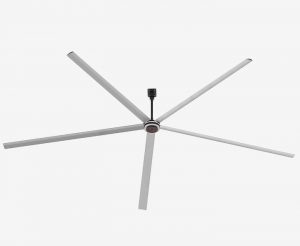Stuffy factories, hot gyms, and massive warehouse floors often suffer from still air that disrupts thermal comfort and drives up energy consumption. This discomfort worsens when typical ceiling fans fail to move air uniformly over large footprints. A remedy? Adopt the HVLS fan, a low-speed system transforming air circulation across vast indoor spaces.
An HVLS fan is a high-volume low-speed fan explicitly built to move air gently yet powerfully over large areas. Ranging from 8 to 24 feet in diameter, these industrial solutions spin at a low rotational pace, pushing a large volume of air without excessive noise or energy draw. By unifying indoor climates, they curb heat stress, bolster productivity, and slash cooling costs. Unlike smaller high-speed devices, HVLS fans create broad, consistent airflow in warehouse floors, manufacturing lines, gymnasiums, and more.

HVLS Fan Operating in a Warehouse
An HVLS fan stands for “High-Volume, Low-Speed.” Put simply, it’s a high-volume low-speed fan that’s engineered to move air across broad areas with minimal rotational velocity. These solutions differ from typical high-RPM fans in that their extremely wide fan blade diameters and slow speed produce gentle, uniform breezes instead of localized gusts.
High-volume means robust airflow at occupant level. Low-speed means less noise, less turbulence, and lower energy consumption. Together, they form a technology that transforms big rooms with stable comfort.
We often see typical ceiling fans in homes or smaller offices. They revolve at higher RPM to create a direct breeze over a limited zone. By contrast, HVLS fans work by pushing a colossal air column from overhead to floor level. This broad, gentle flow gradually spreads outward, delivering cooling benefits to all corners.
When the hvls fan spins, it forms a downward column of air. Once it hits the ground, air travels along the floor horizontally, re-circulating upward to be pulled again by the fan. This cyclical motion fosters even temperatures, limiting hot or cold pockets. Because these fans revolve slowly, occupant comfort remains high—no intense blasts or noise typical of high-RPM smaller fans.
Fans are typically installed overhead (often 15 ft. or taller ceilings), enabling maximum coverage. Thanks to HVLS fans move an enormous volume, you don’t need multiple small fans scattered around the space. It’s a more consolidated, efficient approach.
While HVLS solutions are often linked with summertime relief, these fans also help with winter heating. HVLS fans are designed to operate in reverse or at minimal speed to push warm air near the ceiling down to occupant level. This method reduces heat stratification, so you won’t have wasted warmth stuck overhead. By mixing layers, the building’s HVAC usage can drop, cutting energy overhead during cold months.
In summer, by accelerating sweat evaporation and improving air movement, HVLS fosters a “cooling effect” for workers or visitors. Because the breeze is broad yet gentle, you can reduce your AC setpoint or maintain comfort without overexerting the system. This synergy leads to potential energy savings.
Conclusion: HVLS solutions handle heating and cooling synergy year-round, making them integral in many industrial or commercial buildings—particularly those seeking stable thermal comfort for occupant productivity.
A standard ceiling fan typically measures up to 52–60 inches, spinning quickly to produce localized breezes. They suit smaller rooms or an immediate occupant zone. Ceiling fans move air within a limited radius, which can be enough for a bedroom or small office. But in a warehouse, a single residential unit accomplishes little across tens of thousands of square feet.
Conversely, an HVLS fan can measure 8–24 feet wide, revolve at low rotational speeds, and push thousands of cubic feet of air each minute. Because these fans handle large footprints at once, fewer total fans are needed. That translates to lower energy consumption and fewer mechanical devices to maintain.
Key Distinctions:
Warehouses can be tall, cluttered with racks, and prone to hot or cold pockets. So, how do HVLS solutions tackle these issues effectively?
HVLS fans revolve slowly, generating a downward column of air. This air column disperses outward from the floor, traveling horizontally and then re-circulating upward. The cycle helps unify temperature layers, minimizing heat loss at the ceiling and preventing pockets of stationary air near corners.
Fans move large volumes gently, meaning minimal wind noise or occupant annoyance. Because each revolution handles a wide cross-section, the occupant experiences stable cooling or heating distribution.
Stale or over-warm areas degrade worker productivity. By deploying an HVLS, the environment remains consistent, letting employees focus on tasks rather than fidgeting with fans or suffering from heat stress. Happier employees often yield more consistent output, reinforcing the intangible benefits of advanced air management.
A “low-speed” approach might sound contradictory if you want robust airflow. However, large diameter fans do more with fewer rotations. The synergy of wide fan blade arcs at low RPM ensures broader coverage each pass, reducing energy load.
While smaller fans rely on high RPM to produce noticeable breezes, an HVLS sets a gentle air speed at the occupant zone. The occupant experiences consistent cooling minus sudden gusts. Because the fan’s radius is so large, it can effectively circulate air from overhead down to the floor without requiring an intense spin.
Benefits:
Case: A 16-foot HVLS installed in a 40 ft. tall warehouse decreased the building’s average temperature difference from top to bottom from 15°F to 3°F, proving how a gentle spin fosters uniform climates.
In industrial sites, occupant productivity can dip when heat stress or stale air sets in. By adopting an HVLS solution, you unify the climate, letting employees concentrate on tasks without fatigue or dehydration.
Increased air movement around occupant workstations removes hot air or fumes, supporting clearer breathing and a comfortable environment. This fosters better morale—people or animals, if you run an agricultural barn, remain more active and healthy under consistent airflow.
Fans can help reduce equipment malfunctions, too, by preventing localized hotspots near machinery. The stable environment often extends the longevity of electronics or mechanical systems within the facility. Over time, these intangible gains accumulate into tangible ROI.
Conclusion: If your site suffers from dips in output during peak heat months, an HVLS approach is a proven solution to keep occupant morale high and productivity consistent.

hvls fans in the agricultural cattle barn
“High speed fans” can produce strong breezes, but they typically revolve quickly, targeting smaller zones. If you try to cool a giant warehouse with multiple high-RPM “box fans,” you’ll face scattered coverage and possibly chaotic airflow. Meanwhile, a single HVLS gently unifies the environment.
A typical high-speed mechanical fan might spin well above 300 RPM, generating loud noise and localized airflow. Conversely, HVLS solutions revolve at a low speed—like 50–100 RPM—quietly distributing air over thousands of square feet.
Equation: Fewer fans, less mechanical complexity, more coverage. This synergy leads to stable occupant comfort, minimal background noise, and fewer hazards from cords or floor fans. In short, HVLS is more effective than small high-speed fans for large footprints.
Industry Note: The air movement and control association (AMCA) supports testing standards for fan performance. HVLS solutions often measure extremely high in CFM/watt, reflecting strong coverage with minimal energy use.
When installing an HVLS in a big facility, examine:
Fan may incorporate advanced controls or fan speed settings to adapt throughout the day. Combining HVLS with your hvac system can further unify climate control.
Large HVLS solutions often feature specially contoured “airfoils,” which are advanced blades. These shapes minimize drag and maximize coverage. The fan delivering stable breezes ensures occupant thermal comfort without intense localized blasts. Because the diameter fans revolve slowly, each pass stirs a broad air column pushing stale air away.
Yes, an HVLS might come with a bigger price tag than standard commercial fans. But weigh the “benefits of hvls fans” against multiple smaller or high-speed devices:
Fans are built to last, especially HVLS units with robust motors and heavy-duty designs. Over time, fewer repairs, lower energy overhead, and occupant morale gains often outweigh the initial cost. This is especially relevant in big warehouse floors, distribution centers, or large industrial lines, where occupant thermal comfort is crucial.

HVLS fans
are also known as a “type of fan” that’s more efficient and effective than small high-speed fans in industrial or large commercial contexts. By harnessing slow, broad coverage, they unify occupant conditions quietly and effectively.
How large is a typical HVLS fan?
An hvls fan can measure anywhere from 8 feet up to 24 feet or more in diameter. The correct size depends on your ceiling height and total floor area needing coverage.
Do HVLS fans cool the air like an AC system?
Fans don’t lower the temperature of the air—unlike air conditioners, they move air at low speed to create a breeze. This fosters thermal comfort by accelerating sweat evaporation, making people feel cooler.
Are HVLS fans also suitable for outdoor or partially covered spaces?
Yes. Many low-speed commercial fans can operate effectively in covered outdoor areas, such as pavilions or open-air warehouses. Just ensure the model is rated for humidity or weather exposure.
What about maintenance?
HVLS solutions typically revolve slowly, so they endure less mechanical stress. With routine checks—e.g., verifying the motor, fan blade alignment, and lubrication—they rarely require expensive service or frequent replacement parts.
Do HVLS fans move air better than multiple smaller fans?**
Yes. Their wide diameter fosters a broad air column. By pushing a “column of air” downward at gentle speeds, they unify climates in large footprints more effective than small high-speed fans.
What does HVLS fan stand for? It’s a High-Volume Low-Speed fan—a specialized overhead fan bridging massive coverage, minimal noise, and robust energy advantages. Compared to a ceiling fan in a home or “high speed fans” in small offices, HVLS solutions revolve gradually yet handle large spaces with ease.
At our hvls fans Manufacturing plants, we produce advanced hvls industrial solutions tailored for factories, commercial buildings, sports centers, gyms, schools, and warehouses. By merging airflow mastery with energy efficiency, we help you unify occupant comfort, reduce hvac usage, and maintain stable thermal comfort. Whether you run a 5,000-sq.-ft. auto shop or a 50,000-sq.-ft. distribution center, an HVLS approach can drastically improve your environment, occupant morale, and bottom line.
Fans can also integrate with your existing HVAC system to intensify air movement, slashing reliance on cooling or heating. Because these fans revolve at low speed, they remain quiet and occupant-friendly. Over time, you’ll see energy savings, fewer hot zones, and simpler overhead management—fans no longer have to fight with each other, thanks to HVLS’s wide coverage.
If you’re ready to see how an HVLS solution can reshape your building’s air circulation, reach out to us—we stand prepared to help you choose the best approach for your industrial or commercial site.

Hi, I’m Michael Danielsson, CEO of Vindus Fans, with over 15 years of experience in the engineering and design industry. I’m here to share what I’ve learned. If you have any questions, feel free to contact me at any time. Let’s grow together!